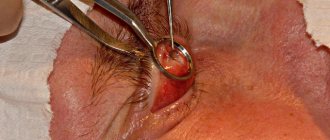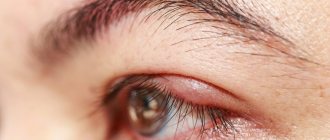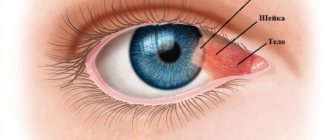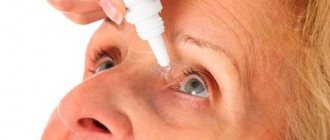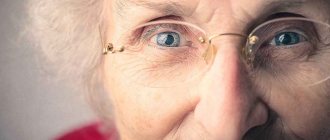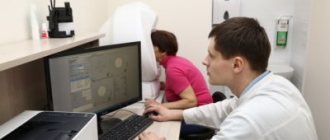Removing a tumor using a high-precision laser is a new method for treating eye diseases. Unlike standard surgical removal of a chalazion, which involves trauma to the soft tissues of the eyelid, a long period of rehabilitation and the use of bandages, laser technology allows the patient to recover in the shortest possible time, as a result of minimal blood loss during removal with minimal damage to the eyelid.
We recommend reading: Chalazion removal
Bloodless technology helps prevent the formation of scar tissue in the postoperative period and promotes a comfortable recovery period.
Indications for laser chalazion removal
Laser therapy for purulent formation on the eyelid is the last measure that is prescribed in advanced situations, namely:
- drug treatment does not bring the desired effect;
- advanced stage of the disease, when the chalazion develops into a cystic neoplasm;
- the width of the cones is more than 0.5 centimeters;
- the disease is prone to relapse;
- a complication develops in the form of eyelid abscesses.
In some situations, the reason for prescribing laser removal is the patient’s personal initiative to reduce the duration of chalazion therapy.
Causes
As mentioned above, a previous infectious and inflammatory process (conjunctivitis, blepharitis, hordeolum, etc.) can lead to the development of chalazion. Other reasons include general oily skin (hyperfunction of the sebaceous glands), injuries and burns of the eye, chronic endocrine, gastroenterological, hematological (presumably) disorders - in short, any pathology that can disrupt the functioning of the glands and the composition of their secretion - as well as helminthiasis, immune system weakness, vitamin deficiency. Sometimes chalazions appear almost simultaneously in two eyes or on different eyelids of the same eye. Recurrence in the same place can be caused by undertreatment or incomplete removal of the previous chalazion.
Preparing for surgery
There is no specific preparation for laser surgery. The treatment is minimally invasive, considered safe and performed on an outpatient basis. But before the operation, it is expected to undergo the necessary tests: analysis for sexually transmitted diseases (HIV, HPV, syphilis, hepatitis), for this purpose a general urine test and a couple of blood tubes are taken to identify the above pathologies.
This stage before the operation helps doctors timely diagnose a dangerous disease and prevent its reproduction outside the patient’s blood, since if one of the sexually transmitted diseases is detected, the doctor will have to perform an operation on the patient, in whose blood there is the causative agent of the dangerous disease. An analysis is required to determine the level of blood clotting; in case of deviation, the patient is prescribed a different treatment regimen.
Before the operation, consultation with an ophthalmologist and ophthalmic surgeon is necessary, and a hardware examination of the visual organs is also prescribed.
During preparation, allergy tests for anesthesia are required; otherwise, the patient will not be allowed to undergo surgery.
Diagnostics
An experienced ophthalmologist can easily diagnose a chalazion by external examination and palpation. When the lump is located on the upper eyelid, the technique of everting the eyelid is used, as a result of which a hailstone is visualized.
Based on the examination results, the doctor excludes the presence of barley or adenocarcinoma (glandular cancer, malignant tumor). If a malignant course of the disease is suspected, a histological examination is prescribed to accurately establish the diagnosis. Visually, such a tumor is rapidly growing, causing a significant increase in temperature.
To find out the causes of chalazion and prevent its recurrence, the ophthalmologist prescribes a number of examinations:
- general blood analysis;
- general urine analysis;
- immunogram (identifies the peculiarities of the immune system);
- tests for sexually transmitted diseases;
- bacterial culture of blood to determine sterility;
- scraping the skin to check for demodicosis (a skin disease caused by the demodex mite);
- analysis for Helicobacter pylori (a bacterium that attacks the stomach and immune system).
Progress of the operation
The main goal of laser surgery is to remove purulent secretions from a clogged sebaceous gland. Progress of the operation:
- the intended surgical area is treated with an antiseptic to eliminate pathogenic microflora;
- local anesthesia is injected into the site of inflammation;
- after this, the eyelid on which the chalazion has formed is fixed with a clamp, it allows you to hold the lump in the desired position;
- the surface of the skin is cut with a laser, first of all the upper layers of the neoplasm are evaporated, after which the purulent contents are removed;
- after removal, antibacterial eye drops are injected into the formed cavity;
- A patch is applied to the damaged area.
The duration of the entire operation is 30 minutes, immediately after its completion the patient can safely continue treatment at home.
Chalazion in childhood
Chalazion occurs less frequently in children than in adults. The causes and symptoms are similar. Preschoolers and primary schoolchildren most often suffer from these unpleasant nodules on the eyelid. For children, conservative treatment is more often used, which responds well to cure. If there is a need for surgery, it is prescribed to first submit blood, feces, and urine to the laboratory for the indicators that will be indicated in the referral. Additional examinations are possible at the discretion of the doctor.
Surgery for children is performed under general anesthesia; local anesthesia is used as an exception. Laser chalazion removal in many clinics is performed only on children over 14 years of age.
The return of pathological changes in the meibomian gland is not uncommon in children. This is why preventive measures are so important. It is imperative to get rid of the dangerous habit of rubbing your eyes to avoid infection.
Postoperative rehabilitation
After the operation, it is important to follow the recommendations for eye restoration; for this you need:
- do not expose the affected eye to the negative effects of water during the first few days of recovery, as there is a risk of infection of the wound;
- You should refrain from removing the crust formed on the wound yourself; you must wait until it disappears on its own;
- Do not touch the surgical site with your hands, much less scratch it;
- in the first couple of days you should not sit at the computer for a long time;
- To prevent discomfort, it is recommended to wear contact lenses prescribed by a doctor;
- After surgery, you cannot stay outside for a long time, since dust particles and pathogens can penetrate into the wound;
- You should not swim in open reservoirs and specialized pools.
It is recommended to strictly follow all prescribed recommendations to your attending physicians to prevent the development of complications.
Symptoms (signs)
Clinical signs depend on the location of the chalazion (on the upper or lower eyelid) and the stages of its formation. The formation gradually increases in size and begins to cause discomfort to the patient. As it progresses, the symptoms increase. Among them are:
- swelling;
- redness of the mucous membrane of the eye;
- annoying itching;
- lacrimation;
- painful sensations when touched;
- astigmatism (decreased vision clarity due to pressure of the formation on the cornea);
- visual impairment (decreased visual acuity);
- suppuration;
- throbbing pain;
- fever.
On palpation, tumor mobility is noted. Externally, the formation looks like a small pea.
In the first stages, it is almost impossible to distinguish a chalazion from a stye, especially if it is located on the lower eyelid. However, when the lump begins to increase in size, you need to consult a doctor to prescribe the correct therapy. Self-medication threatens the development of serious complications, so do not hesitate to visit an ophthalmologist. If the lump becomes infected, surgery will be required; in the early stages of the disease, you can simply take antibiotics.
Benefits of laser removal
There are a large number of positive qualities of laser therapy for chalazion:
- many patients who have undergone laser surgery are allowed to go home literally a couple of hours after the growth is removed;
- laser removal is tolerated by patients much easier than mechanical removal of purulent formation with a scalpel;
- thanks to the targeted effect of the laser beam, it is possible to remove the chalazion capsule without affecting the healthy tissue of the eyelid;
- postoperative sutures are not applied, since the entire operation is bloodless;
- during the rehabilitation period there is no need to wear a protective eye patch, which in turn increases the patient’s quality of life during the recovery period;
- when removing a lump, the risk of bleeding is unlikely, so the likelihood of postoperative hematomas is insignificant;
- in addition to removal, the laser has antibacterial properties, due to which the wound is disinfected;
- after laser removal, the development of relapse is significantly less than with mechanical removal of the chalazion;
- Laser technology has a minimal number of contraindications, in contrast to standard growth removal.
Treatment
Once the diagnosis is made, the doctor prescribes the appropriate treatment. You cannot self-medicate, since medications are prescribed depending on the stage of the disease and the individual characteristics of the patient. For small formations, different types of drugs and procedures are used:
- bactericidal drops (reduce the risk of bacterial infection);
- special ointments for chalazion (applied under the eyelids and promote dilation of the ducts);
- physiotherapeutic procedures (warming with dry heat, electrophoresis, magnetic therapy, ultraviolet irradiation, compresses help expand the ducts);
- massage movements (reduce formation).
Antibiotics included in ointments and drops prevent possible complications. If this regimen is ineffective, the patient is prescribed corticosteroid injections (hormonal drugs) into the area of the tumor and antibiotics.
If hormonal therapy does not have an effect, surgical removal of the contents of the lump is used. The operation takes no more than half an hour and is performed under local anesthesia. The most common method: opening the capsule, removing the formation, suturing. In modern medicine, rapid removal of lumps with a laser is practiced. In this case, the patient does not require rehabilitation.
Note. Surgical removal of a chalazion is a simple and safe procedure. In order to reduce the risk of postoperative complications (swelling, hematoma formation, inflammation, bleeding, suppuration), follow the rules of hygiene and all doctor’s recommendations.
Prevention of chalazion
To prevent the recurrence of the disease, you must adhere to the following recommendations:
- if possible, overcome all chronic infectious diseases;
- regularly carry out hygiene procedures, wash your eyes with mild cleansers;
- do not take products containing large amounts of artificial colors and flavor enhancers;
- start observing a sleep-wake schedule, spending at least 8 hours a day sleeping;
- avoid depressive and stressful situations;
- take multivitamin complexes regularly;
- start playing sports, eat more vegetables and fruits.
Complications
Chalazion is treatable and the prognosis is usually favorable. However, with self-medication and late consultation with a doctor, various complications may develop:
- formation of a cyst, which opens to form a fistula tract;
- transformation into a chronic form with frequent periods of exacerbation;
- abscess (local inflammation with suppuration with the addition of a secondary bacterial infection);
- development of conjunctivitis;
- inflammation of the cornea of the eye (the front convex part of the eyeball);
If the disease recurs frequently, you should lead a healthy lifestyle, strengthen your immune system, and get rid of pockets of chronic infections.
Useful video
Chalazion therapy is a complex and difficult process. The laser removal method is not only effective, but also safe; the laser will help remove the purulent capsule in 15 minutes without any consequences for the patient.
Author's rating
Author of the article
Alexandrova O.M.
Articles written
2029
about the author
Was the article helpful?
Rate the material on a five-point scale!
( 3 ratings, average: 5.00 out of 5)
If you have any questions or want to share your opinion or experience, write a comment below.
